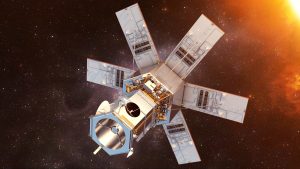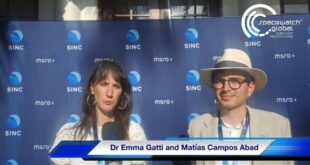
WorldView-4, DigitalGlobe’s latest high-resolution Earth observation satellite, was finally, and successfully, launched out of Vandenberg Air Force Base, California, on a United Launch Alliance (ULA) Atlas-V launch vehicle. The launch took place on 11 November 2016, just under two months after its scheduled launch.
The lengthy delay was caused by a wildfire that threatened Vandenberg Air Force Base, located on the Californian coast. It took weeks for firefighters to drive the wildfire back from the base and put it out.
The WorldView-4 satellite, and the Atlas-V launch vehicle, are both built by U.S. aerospace giant Lockheed Martin.
The WorldView-4 satellite was inserted into a Sun-synchronous orbit at an altitude of 617 kilometres. Once operational, WorldView-4 will orbit Earth once every 90 minutes and its camera will capture up to 680,000 square kilometres of the Earth’s surface every day. The resolution of the WorldView-4 camera is 30 centimetres.
According to DigitalGlobe’s spokesman, Kevin Bullock, the launch of WorldView-4, “more than doubles our 30cm collection capacity, which is far and away the best in the industry. It takes some of the load off of WorldView-3, since we’ll now have two very similar versions of the industry’s best satellite for tasking instead of just one. In short, it helps us do everything we do even better than we do it today.”
As well as traditional military and intelligence applications, DigitalGlobe’s capabilities and services are increasingly finding applications in the energy, commodities, transportation, and financial sectors as satellite imagery, computational learning, and big data analytics can provide these and other sectors more accurate, timely, and scalable data than ever before.
DigitalGlobe, as well as its direct competitor Airbus, are facing stiffer competition from companies like Terra Bella (owned by Google’s parent company Alphabet), Planet, and UrtheCast, all of whom use smaller and cheaper satellites.
“The addition of WorldView-4 to our constellation and the improvements we’re making to our associated systems, platforms, software and teams will enable our end users to solve even more problems with more accuracy and more confidence,” added DigitalGlobe’s Bullock.
DigitalGlobe has a large roster of governmental and corporate clients throughout the Middle East.
Original published at: http://www.spacewatchme.com/2016/11/digitalglobes-worldview-4-commercial-earth-observation-satellite-successfully-launched
 SpaceWatch.Global An independent perspective on space
SpaceWatch.Global An independent perspective on space

